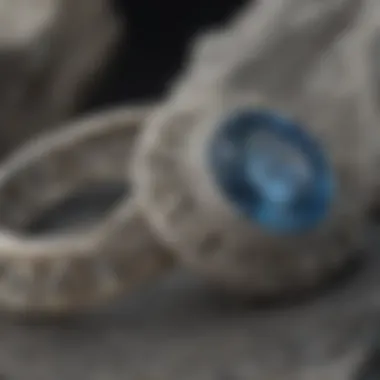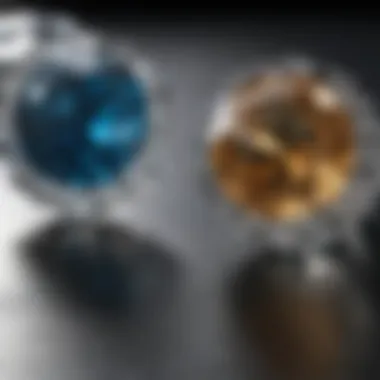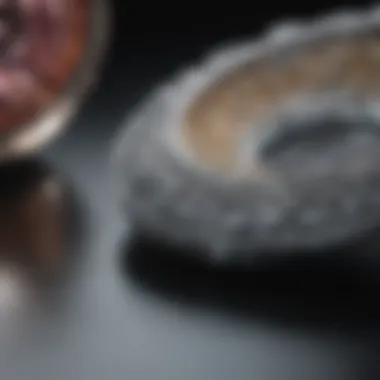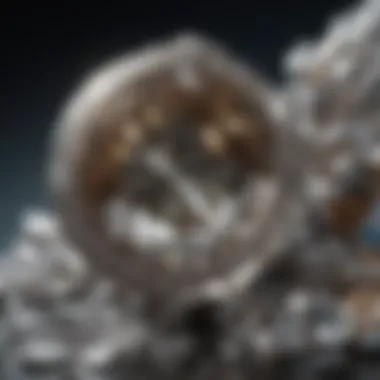Platinum vs White Gold: A Detailed Comparison of Precious Metals


Overview of Precious Metals
When delving into the exquisite world of fine jewelry, the choice between platinum and white gold holds significant weight. Both platinum and white gold are highly sought-after metals in the realm of jewelry, each possessing distinct qualities that set them apart. Understanding the characteristics of these precious metals is paramount in making well-informed decisions when selecting jewelry pieces, emphasizing durability, maintenance requirements, and overall value.
Properties of Platinum and White Gold
Composition and Purity
Platinum, a noble metal, is renowned for its purity and hypoallergenic properties, making it an excellent choice for individuals with sensitive skin. Conversely, white gold is a blend of yellow gold and other white metals such as palladium or silver, coated with rhodium to achieve its signature lustrous appearance.
Durability and Hardness
Platinum boasts exceptional durability, being extremely resistant to tarnishing and corrosion. Its density and weight provide a substantial feel to jewelry pieces, ensuring longevity. On the other hand, while white gold is durable, it may require periodic re-coating with rhodium to maintain its white hue and luster.
Maintenance Requirements
Proper maintenance is crucial to preserving the brilliance of platinum and white gold jewelry. While platinum’s natural white sheen resists fading and tarnishing over time, occasional polishing can restore its mirror-like finish. White gold, however, necessitates more frequent re-plating to uphold its silvery radiance.
Value and Pricing
The value of platinum and white gold jewelry fluctuates based on factors such as market demand, craftsmanship, and metal purity. Platinum’s rarity and higher purity levels typically command a higher price compared to white gold. Understanding these pricing dynamics is essential for those seeking both luxury and longevity in their jewelry investments.
Synthesizing the Distinctions
Introduction


As we embark on the journey of comparing two prestigious metals, platinum, and white gold, it is imperative to delve deep into their essence to discern the intricate subtleties that set them apart. Understanding the fundamental disparities between platinum and white gold is not only essential for jewelry connoisseurs but also for those inclined towards the geological and aesthetic aspects of precious metals. This comprehensive comparison aims to unravel the mystique surrounding these precious metals, offering a holistic view of their composition, physical attributes, maintenance requirements, value propositions, and the environmental footprints they leave behind. By meticulously scrutinizing every facet of platinum and white gold, we endeavor to equip our readers with the knowledge necessary to make informed decisions when investing in jewelry pieces. Buckle up as we navigate through the labyrinth of platinum versus white gold, unearthing the nuances that make them shine in their unique splendor.
Composition and Purity
In the realm of jewelry, the composition and purity of precious metals play a pivotal role in determining their quality and attributes. This section provides a detailed exploration of the composition and purity of platinum and white gold, shedding light on the foundational aspects that differentiate these metals in the world of luxury accessories. By understanding the intricacies of composition and purity, jewelry enthusiasts, collectors, and designers can make informed decisions when selecting pieces for their collections.
Platinum Composition
Platinum, known for its rarity and luxurious appeal, boasts a unique composition that sets it apart from other metals. Primarily composed of platinum group metals such as iridium, osmium, and palladium, platinum exhibits exceptional durability and resistance to corrosion. The purity of platinum is often measured in parts per thousand, with common purities ranging from 850 to 950 parts per thousand. This high level of purity contributes to platinum's distinct white luster and hypoallergenic properties, making it a preferred choice for individuals with sensitive skin. Understanding the composition of platinum is essential in recognizing its value and suitability for various jewelry applications.
White Gold Composition
White gold, a popular alternative to platinum, is a versatile metal that combines gold with other white metals such as nickel, zinc, or palladium to achieve its distinctive color. The purity of white gold is denoted in karats, with 18K and 14K being common variants in the jewelry industry. While white gold offers a more affordable option compared to platinum, its composition may vary depending on the alloy used, impacting factors such as durability and color retention. It is imperative for consumers to grasp the composition of white gold to assess its quality and compatibility with their style preferences and budget constraints.
Composition and Purity
In the realm of jewelry, distinguishing between platinum and white gold often leads to considering their \
Maintenance and Care
In this section, we will delve deep into the crucial aspects of maintenance and care for both platinum and white gold, essential for preserving the longevity and beauty of your jewelry pieces. Understanding the maintenance requirements of these precious metals is pivotal in ensuring your investment remains pristine over time, reflecting their exquisite craftsmanship and design.
When it comes to scratch resistance, platinum boasts exceptional durability, naturally resistant to wear and tear. Its inherent strength provides a significant advantage, making it ideal for daily wear jewelry that withstands the rigors of daily activities. On the other hand, white gold, although durable, may require additional care due to its alloy composition, which includes other metals like nickel or palladium to achieve its white hue. These alloys can influence the metal's scratch resistance, warranting periodic maintenance to retain its pristine luster.
Polishing and refinishing play a vital role in maintaining the aesthetic appeal of both platinum and white gold jewelry. While platinum exhibits a natural luster that endures, occasional polishing can enhance its brilliance, revitalizing its shine. White gold, however, may require regular polishing to maintain its reflective finish, especially if it contains rhodium plating. Refinishing is also essential for white gold pieces to ensure the longevity of the plating and preserve the metal's color consistency.


Considering allergic reactions, platinum emerges as an excellent choice for individuals with sensitive skin. Hypoallergenic properties of platinum make it suitable for prolonged wear, minimizing the risk of skin irritation or allergic reactions. In contrast, white gold alloys could trigger reactions in some individuals sensitive to metals like nickel. Understanding your skin's tolerance to metals is crucial in selecting the right metal for your jewelry, ensuring both comfort and style complement each other seamlessly.
Value and Pricing
In discussing the topic of Value and Pricing within the context of this article comparing Platinum and White Gold, it is essential to delve into the intricate web of factors that influence the monetary worth of these precious metals. The significance of understanding the value and pricing of jewelry materials lies in the fact that it directly affects consumers' decisions when selecting pieces for personal use or investment. By highlighting the key aspects of value and pricing, such as market fluctuations, manufacturing costs, and cultural perceptions, we can gain a more profound insight into the true worth of Platinum versus White Gold.
Market Value
The market value of Platinum and White Gold fluctuates depending on various factors such as demand, supply, economic conditions, and geopolitical events in the regions where these metals are mined or traded. Platinum, known for its rarity and versatility in industrial applications, often commands a higher market value compared to White Gold. Moreover, fluctuations in the automotive and technology sectors greatly influence the market value of Platinum due to its use in catalytic converters and electronic components. Conversely, White Gold, being an alloy of Gold and other metals, is more susceptible to price variations based on the prevailing market prices of Gold and other base metals.
Cost Factors
When considering the cost factors associated with Platinum and White Gold, it is crucial to examine the expenses involved in mining, refining, crafting, and distributing these metals. Platinum, being a denser and heavier metal than Gold, incurs higher production costs due to its extraction complexity and labor-intensive refining process. Additionally, the purity levels of Platinum, measured in parts per thousand, significantly impact its final cost, with higher purity commanding a premium price. Conversely, White Gold's cost factors encompass the prices of Gold, as well as alloying metals such as Nickel, Palladium, or Silver, which play a vital role in determining its overall cost and affordability.
Resale Value
The resale value of Platinum and White Gold is another crucial aspect to consider, especially for individuals looking to invest in jewelry pieces with potential appreciation over time. Platinum, known for its inertness, rarity, and enduring aesthetic appeal, tends to retain a higher resale value compared to White Gold. The longevity and timeless allure of Platinum contribute to its desirability in the secondary market, making it a sought-after choice for collectors and investors. On the other hand, White Gold's resale value is influenced by factors such as Gold prices, market trends, and the condition of the jewelry piece, with well-maintained and iconic designs often fetching higher resale prices.
Overall, understanding the dynamics of market value, cost factors, and resale value is essential in making informed decisions when choosing between Platinum and White Gold jewelry, ensuring both aesthetic satisfaction and long-term value retention for discerning buyers.
Aesthetics and Design
In the domain of jewelry, aesthetics and design play a pivotal role in defining the allure and appeal of pieces crafted from precious metals. When comparing platinum and white gold, delving into their aesthetics and design nuances unveils a realm of artistic expression and sophistication unlike any other. A meticulous examination of the intricate details and finishes of these metals reveals a spectrum of characteristics that cater to diverse tastes and preferences.
Aesthetics and design hold immense significance in this article as they serve as the foremost visual cues that captivate individuals towards specific jewelry pieces. The gleaming radiance of platinum exudes a luxurious charm that complements both modern and classic designs with equal finesse. Contrasted with the elegant and timeless allure of white gold’s subtle sheen, the design possibilities are boundless, reflecting the wearer's unique style and personality.


In exploring aesthetics and design within the context of platinum versus white gold, it is essential to consider the intricate patterns, settings, and embellishments that enhance the overall visual impact of jewelry pieces. The design versatility of platinum allows for elaborate engravings and intricate details that elevate the sophistication of the piece, while white gold's luminosity accentuates the brilliance of gemstones, creating a harmonious blend of metal and stone.
When contemplating aesthetics and design in the realm of jewelry, individuals are faced with a plethora of choices that reflect their individuality and tastes. Whether opting for the understated elegance of white gold or the opulent beauty of platinum, each metal carries a unique allure that resonates with different preferences, making the selection process a deeply personal and expressive journey.
Environmental and Ethical Considerations
As we delve into the world of precious metals, it becomes imperative to consider the environmental and ethical implications of our choices. This section aims to shed light on the vital importance of sustainability and ethical mining practices in the jewelry industry. While the allure of platinum and white gold may captivate us with their beauty and elegance, understanding their environmental footprint is crucial for conscious consumerism.
Sustainability
Sustainability is a key pillar in the framework of responsible jewelry production. When we talk about sustainability in the context of platinum and white gold, we explore how these metals are sourced, processed, and their impact on the environment. From the extraction of raw materials to the refining process, sustainability practices play a significant role in ensuring the long-term viability of these metals as jewelry choices. Additionally, assessing the recyclability and eco-friendliness of platinum and white gold contributes to a more sustainable jewelry industry.
Mining Practices
Mining practices form the backbone of the jewelry supply chain, greatly influencing the environmental and ethical landscape. The discussion of mining practices in relation to platinum and white gold entails an examination of extraction methods, labor conditions, and community impacts. By delving into the specifics of mining operations, such as responsible sourcing, fair labor practices, and community engagement, we gain a holistic understanding of how these practices shape the jewelry we wear. The emphasis on ethically sourced materials and promoting transparency in mining practices is instrumental in fostering a more responsible and sustainable jewelry industry.
Conclusion
In this final section of our thorough exploration into platinum and white gold, it is imperative to underscore the significance of understanding the disparities between these two esteemed metals. The meticulous evaluation conducted throughout this article serves as a beacon for individuals seeking to make well-informed decisions when acquiring jewelry pieces.
By delving into the intricacies of platinum composition compared to white gold, we illuminate the elemental composition variance that dictates each metal's unique properties. Understanding the physical characteristics, like color, density, strength, and durability, empowers readers to appreciate the nuanced differences that influence jewelry maintenance and longevity.
Maintenance and care play pivotal roles in the longevity of jewelry. Exploring scratch resistance, polishing techniques, and potential allergic reactions arms jewelry enthusiasts with the knowledge essential for preserving the beauty and value of their cherished pieces over time.
The narrative extends into the realms of value and pricing. Insight into market valuation, cost determinants, and factors affecting resale value equip readers with a comprehensive understanding of the financial aspects underpinning the selection between platinum and white gold jewelry.
Aesthetics and design considerations round out the analysis, discussing the finish, luster, and design versatility offered by these metals. Recognizing the environmental and ethical implications of sustainability and mining practices contributes towards making conscientious jewelry decisions.
In essence, this comparison between platinum and white gold transcends mere aesthetics; it encapsulates a holistic view encompassing craftsmanship, monetary value, and ethical considerations. The information presented serves as a compass guiding individuals through the intricate terrain of jewelry selection, facilitating choices aligned with personal preferences and values.
Ultimately, the knowledge gained from this comparative analysis elevates the jewelry selection process from mere transaction to a discerning choice reflective of individual style, values, and longevity.







